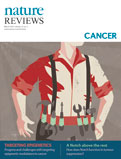|
| TABLE OF CONTENTS | ||||||||||||||||||||||||||||||||||||||||
| March 2017 Volume 17 Number 3 | Advertisement | |||||||||||||||||||||||||||||||||||||||
| In this issue
|
| ||||||||||||||||||||||||||||||||||||||
| ||||||||||||||||||||||||||||||||||||||||
 | ||||||||||||||||||||||||||||||||||||||||
| ||||||||||||||||||||||||||||||||||||||||
| REVIEWS | Top | |||||||||||||||||||||||||||||||||||||||
| Notch as a tumour suppressor Craig S. Nowell & Freddy Radtke p145 | doi:10.1038/nrc.2016.145 In this Review, Nowell and Radtke outline the accumulating evidence that Notch functions as a tumour suppressor in a range of cancers, and present potential mechanisms by which loss of Notch signalling could promote tumorigenesis. Abstract | Full Text | PDF | ||||||||||||||||||||||||||||||||||||||||
| A chemical probe toolbox for dissecting the cancer epigenome Jake Shortt, Christopher J. Ott, Ricky W. Johnstone & James E. Bradner p160 | doi:10.1038/nrc.2016.148 This review summarizes the state of the art in chemical probes targeting molecular processes operating at the chromatin interface in cancer cells. It seeks to provide a chemical toolbox for use by scientists to dissect epigenetic vulnerabilities of tumour biology. Abstract | Full Text | PDF | Supplementary information | ||||||||||||||||||||||||||||||||||||||||
| SUMO and the robustness of cancer Jacob-Sebastian Seeler & Anne Dejean p184 | doi:10.1038/nrc.2016.143 Sumoylation is an important mechanism in cellular responses to stress, and appears to be upregulated in many cancers. This Review argues that sumoylation protects the stability and functionality of otherwise easily misregulated gene expression programmes and signalling pathways of cancer cells. Abstract | Full Text | PDF | ||||||||||||||||||||||||||||||||||||||||
| PERSPECTIVES | Top | |||||||||||||||||||||||||||||||||||||||
| OPINION Precision diagnostics: moving towards protein biomarker signatures of clinical utility in cancer Carl A. K. Borrebaeck p199 | doi:10.1038/nrc.2016.153 This Opinion article focuses on the trends and progress being made in identifying protein biomarker signatures of clinical utility in cancer using, in particular, blood-based proteomics. Abstract | Full Text | PDF | ||||||||||||||||||||||||||||||||||||||||
| ||||||||||||||||||||||||||||||||||||||||
You have been sent this Table of Contents Alert because you have opted in to receive it. You can change or discontinue your e-mail alerts at any time, by modifying your preferences on your nature.com account at: www.nature.com/myaccount For further technical assistance, please contact our registration department For print subscription enquiries, please contact our subscription department For other enquiries, please contact our feedback department Nature Publishing Group | One New York Plaza, Suite 4500 | New York | NY 10004-1562 | USA Nature Publishing Group's worldwide offices: Macmillan Publishers Limited is a company incorporated in England and Wales under company number 785998 and whose registered office is located at The Campus, 4 Crinan Street, London, N1 9XW. © 2017 Nature Publishing Group, a division of Macmillan Publishers Limited. All Rights Reserved. |
 |









No comments:
Post a Comment